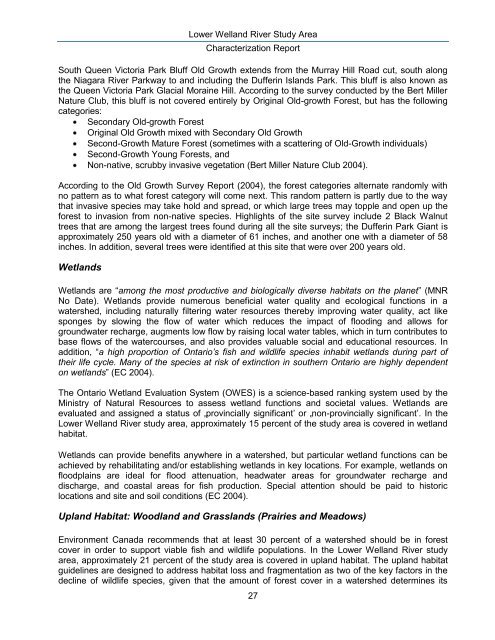Lower Welland River Characterization Report - Niagara Peninsula ...
Lower Welland River Characterization Report - Niagara Peninsula ...
Lower Welland River Characterization Report - Niagara Peninsula ...
You also want an ePaper? Increase the reach of your titles
YUMPU automatically turns print PDFs into web optimized ePapers that Google loves.
<strong>Lower</strong> <strong>Welland</strong> <strong>River</strong> Study Area<br />
<strong>Characterization</strong> <strong>Report</strong><br />
South Queen Victoria Park Bluff Old Growth extends from the Murray Hill Road cut, south along<br />
the <strong>Niagara</strong> <strong>River</strong> Parkway to and including the Dufferin Islands Park. This bluff is also known as<br />
the Queen Victoria Park Glacial Moraine Hill. According to the survey conducted by the Bert Miller<br />
Nature Club, this bluff is not covered entirely by Original Old-growth Forest, but has the following<br />
categories:<br />
Secondary Old-growth Forest<br />
Original Old Growth mixed with Secondary Old Growth<br />
Second-Growth Mature Forest (sometimes with a scattering of Old-Growth individuals)<br />
Second-Growth Young Forests, and<br />
Non-native, scrubby invasive vegetation (Bert Miller Nature Club 2004).<br />
According to the Old Growth Survey <strong>Report</strong> (2004), the forest categories alternate randomly with<br />
no pattern as to what forest category will come next. This random pattern is partly due to the way<br />
that invasive species may take hold and spread, or which large trees may topple and open up the<br />
forest to invasion from non-native species. Highlights of the site survey include 2 Black Walnut<br />
trees that are among the largest trees found during all the site surveys; the Dufferin Park Giant is<br />
approximately 250 years old with a diameter of 61 inches, and another one with a diameter of 58<br />
inches. In addition, several trees were identified at this site that were over 200 years old.<br />
Wetlands<br />
Wetlands are “among the most productive and biologically diverse habitats on the planet” (MNR<br />
No Date). Wetlands provide numerous beneficial water quality and ecological functions in a<br />
watershed, including naturally filtering water resources thereby improving water quality, act like<br />
sponges by slowing the flow of water which reduces the impact of flooding and allows for<br />
groundwater recharge, augments low flow by raising local water tables, which in turn contributes to<br />
base flows of the watercourses, and also provides valuable social and educational resources. In<br />
addition, “a high proportion of Ontario‟s fish and wildlife species inhabit wetlands during part of<br />
their life cycle. Many of the species at risk of extinction in southern Ontario are highly dependent<br />
on wetlands” (EC 2004).<br />
The Ontario Wetland Evaluation System (OWES) is a science-based ranking system used by the<br />
Ministry of Natural Resources to assess wetland functions and societal values. Wetlands are<br />
evaluated and assigned a status of „provincially significant‟ or „non-provincially significant‟. In the<br />
<strong>Lower</strong> <strong>Welland</strong> <strong>River</strong> study area, approximately 15 percent of the study area is covered in wetland<br />
habitat.<br />
Wetlands can provide benefits anywhere in a watershed, but particular wetland functions can be<br />
achieved by rehabilitating and/or establishing wetlands in key locations. For example, wetlands on<br />
floodplains are ideal for flood attenuation, headwater areas for groundwater recharge and<br />
discharge, and coastal areas for fish production. Special attention should be paid to historic<br />
locations and site and soil conditions (EC 2004).<br />
Upland Habitat: Woodland and Grasslands (Prairies and Meadows)<br />
Environment Canada recommends that at least 30 percent of a watershed should be in forest<br />
cover in order to support viable fish and wildlife populations. In the <strong>Lower</strong> <strong>Welland</strong> <strong>River</strong> study<br />
area, approximately 21 percent of the study area is covered in upland habitat. The upland habitat<br />
guidelines are designed to address habitat loss and fragmentation as two of the key factors in the<br />
decline of wildlife species, given that the amount of forest cover in a watershed determines its<br />
27

















